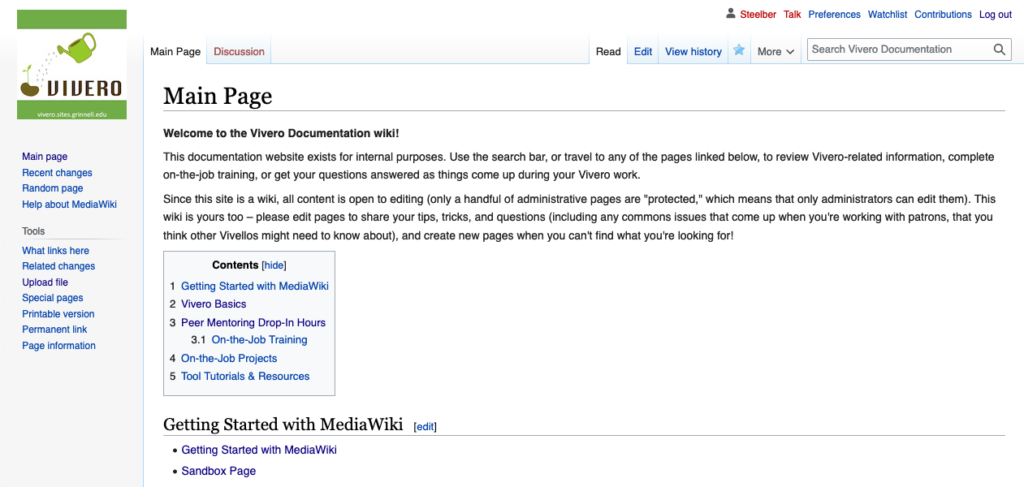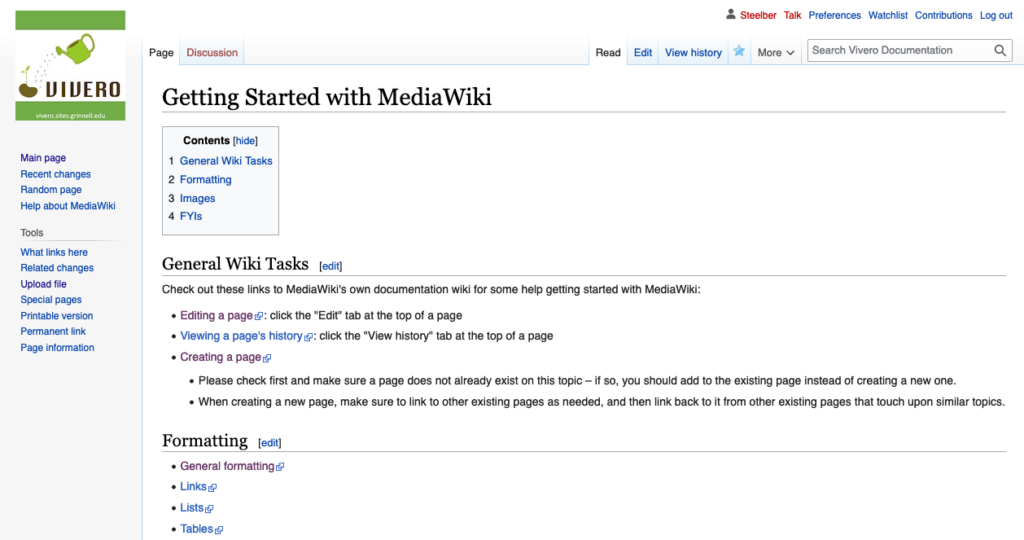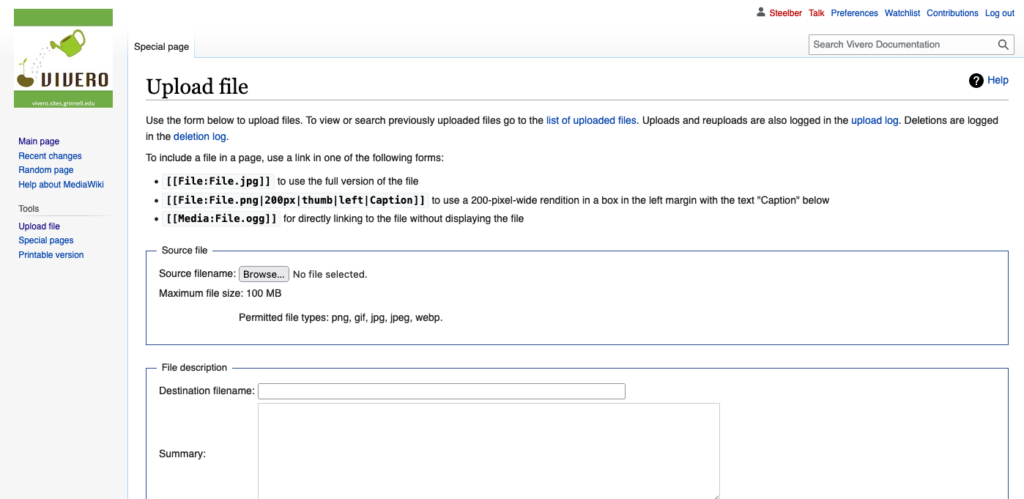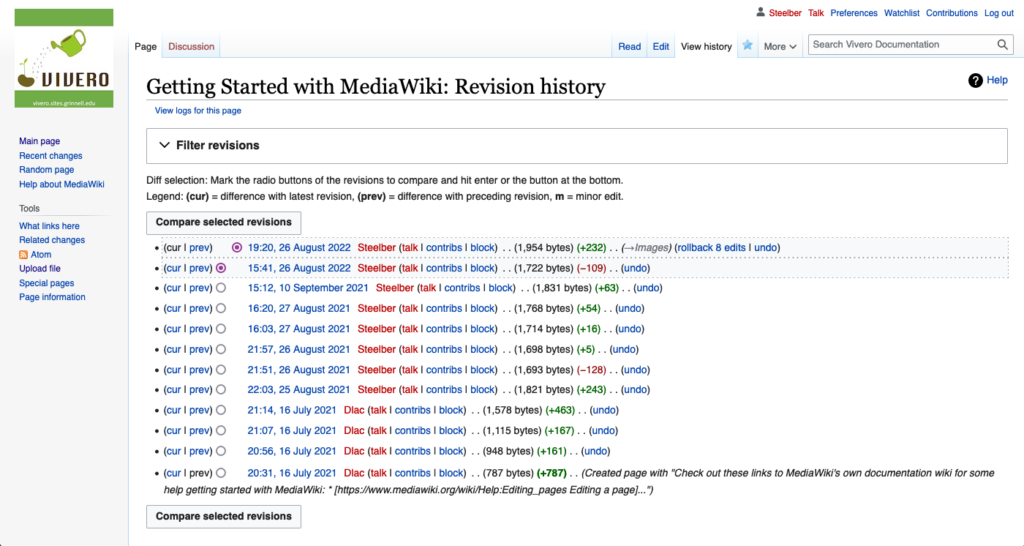 This tutorial by Tierney Steelberg, Digital Liberal Arts Specialist at Grinnell College’s DLAC, is licensed under a Creative Commons Attribution-NonCommercial-ShareAlike 4.0 International License.
This tutorial by Tierney Steelberg, Digital Liberal Arts Specialist at Grinnell College’s DLAC, is licensed under a Creative Commons Attribution-NonCommercial-ShareAlike 4.0 International License.
Table of Contents
What Is MediaWiki?
MediaWiki is an open-source “collaboration and documentation platform” (source: MediaWiki) used for building, you guessed it, wikis! Arguably the world’s most well-known wiki, Wikipedia, is powered by MediaWiki.
Vivero Documentation Wiki
The Vivero Documentation wiki at https://documentation.vivero.sites.grinnell.edu/ is a MediaWiki site. This documentation website exists for internal purposes: it is only available to logged-in users. You can use the search bar, or travel to any of the pages linked from the homepage, to review Vivero-related information, complete on-the-job training, or get your questions answered as things come up during your Vivero work.
Our documentation site is a wiki, which means that all content is open to editing (only a handful of administrative pages are “protected,” which means that only administrators can edit them). This wiki is yours too – please edit pages to share your tips, tricks, and questions (including any commons issues that come up when you’re working with patrons, that you think other Vivellos might need to know about), and create new pages when you can’t find what you’re looking for!
Logging In
Each Vivello has their own account: check your email for account activation/password set-up instructions that were emailed to you.We have set these accounts up for you using your Grinnell username and Grinnell email address.
If you ever forget your password, it’s no trouble to reset it: simply click the “Forgot your password?” link on the log in page, and enter either your username or email address into one of the text boxes provided. You will receive an email from the site with password reset instructions.
Page Content
MediaWiki makes it easy to edit existing pages and create new ones. On the back-end editing view of a MediaWiki page, you’ll see a simple text box: all text formatting options and content styling happen through markup, rather than the kind of text editor style bar that some programs have. You format and style your own pages using wiki markup. For example, to format a word in italic, you include it in two pairs of apostrophes like ''this''.
Editing a Page
To edit an existing page, navigate to it and click the “Edit” tab in the top right. You’ll see the page’s editing view, in wiki markup form instead of as styled text.
Here’s what the Getting Started with MediaWiki page looks like on the front end, in Read mode:
And here’s what that same page looks like on the back end, after you click the Edit tab at the top:

You can see the work that MediaWiki does for you in turning your wiki markup into page styling. It even creates a Table of Contents box at the top based on your headings, so page readers can easily navigate to their desired section (especially helpful on long pages!).
MediaWiki user manual: Editing pages.
Creating a Page
There are a couple of different ways you can create a new page: the easiest is to use the search bar and search for a topic, then click the red “Create the page” link that appears under the search bar, above the search results (if there are any).
You can also create new pages by making an internal link from within an existing MediaWiki page, by putting text in double brackets like this: [[Title of New Page]]. When you do this with an existing page title, it links to that page. When you do it with a title for a page that does not exist yet, MediaWiki will prompt you to create the page when you click the link (which will show up as red, as opposed to the blue links to existing pages).
MediaWiki user manual: Starting a new page.
Writing Page Content with Wiki Markup
You will use wiki markup to write your pages. “Markup languages are ways of annotating an electronic document. Usually markup will either specify how something should be displayed or what something means. ” (Source: University of London, “An introduction to markup”)
This means that you will add additional characters as you type, that MediaWiki will interpret on the back end and render with your intended formatting on the front-end/Read version of the page.
| Description | You type | You get |
|---|---|---|
| Italic text |
''italic'' |
italic |
| Bold text |
'''bold''' |
bold |
| Bold and italic |
'''''bold & italic''''' |
bold & italic |
| Escape wiki markup |
<nowiki>no [[wiki]] ''markup''</nowiki>
|
no [[wiki]] ”markup” |
| Section Headings of different levels
(Skip Level 1, it is page name level.) |
== Level 2 == === Level 3 === ==== Level 4 ==== ===== Level 5 ===== ====== Level 6 ====== |
Level 2Level 3Level 4Level 5Level 6 |
| Horizontal rule |
Text before ---- Text after |
Text before
Text after |
| Internal wiki link |
[[Sandbox Page]] |
Sandbox Page |
| External link |
[https://vivero.sites.grinnell.edu Vivero site] |
Vivero site |
| Bullet list |
* Start each line * with an asterisk (*). ** More asterisks give deeper *** and deeper levels. * Line breaks <br />don't break levels. *** But jumping levels creates empty space. Any other start ends the list. |
Any other start ends the list. |
| Numbered list |
# Start each line # with a number sign (#). ## More number signs give deeper ### and deeper ### levels. # Line breaks <br />don't break levels. ### But jumping levels creates empty space. # Blank lines |
|
Source: adapted from MediaWiki user manual Formatting guide.
Try it yourself: go to your Sandbox Page (the one with your name on it) and play around with writing some content and using wiki markup for styling and formatting.
Leveling Up Your Content & Styling
Check out these pages from the MediaWiki user manual to level up your content and styling:
- Lists
- Images
- Tables
- Keep exploring the Formatting page (as well as the rest of the user manual)
FYI: you can upload images of your own using the “Upload file” option under “Tools” in the left-hand menu, and then add them to your pages using a file link based on the title of the file (don’t forget to add alt text!). Files added to the wiki get their own page with the metadata that you assign to them upon creation, and others can use and reuse them too.
A MediaWiki Ecosystem
Linking Pages
When creating a new page, make sure to link to other existing pages as needed, and then link back to it from other existing pages that touch upon similar topics. This will help others find the pages you create.
Making Contributions
The power of a wiki is in knowledge being shared communally and democratically: all users have the power to make contributions to existing content (or to create brand new content of their own!). As you work on your projects and staff drop-in shifts as a Vivello and as you encounter new ideas and tools, troubleshooting tips, or questions, please update any of the existing wiki pages with information you think other Vivellos should know!
All the tool pages have a Notes section at the bottom that you can used to add notes on the tool that might not fit elsewhere. But you can feel free to edit any and all pages as you see fit.
After you edit a page, you can summarize the extent of your edits in the “Summary” box before you click the “Save changes” button. You can also tick the “This is a minor edit” box without summarizing if you are simply making a minor edit like adjusting a typo.
Viewing/Restoring Revisions
You can view any page’s revision history by clicking the “View history” tab at the top right of the page. This will show you a list of revisions, along with information about when they were made, who made them, and their summary of edits (when available). You can click on a past version to view the past page content or even compare selected revisions. This is a great tool to use if you accidentally delete someone else’s content while making a contribution, or if you want to check past information.
Basic Accessibility Recommendations
- Structure & Layout
- ensure a logical document/page structure (for example, make sure to nest your headings correctly: H2 > H3 > H4)
- use tables only for tabular data, not for page layout
- Design
- consider your use of color (color contrasts, colors that are too bright, colors conveying meaning…)
- consider the legibility of your typeface and font size
- Content
- break up walls of text
- provide text alternatives to multimedia content (alternative text, a.k.a. alt text, for images, captions or transcripts for videos), and ensure accessibility of other external files (such as PDFs)
- create links that make sense out of context (avoid “click here”)
Activity: Build a Fake Wikipedia Page
As part of the Spring 2024 Retreat, Vivero fellows will learn how to use MediaWiki. Team up and create a fake Wikipedia page for any topic or thing. The page must include the following:
- a photo
- 2 or more Headers/sections
- A “quick facts” table
- External Links to other pages/ websites
- Must be linked to this page under the “Training Pages” using the internal link method
For the sake of time and for this training and this training only, feel free to use a generative AI (Claude.Ai, ChatGPT) to create parts of the text. We are looking more at your ability to create and format pages than your ability to write in this case.
See the Mabel Corndog page in the wiki for an example! You can mine this page, and others, as a resource for formatting, by clicking edit and then copying and pasting without making or saving any changes.
Resources
- MediaWiki user manual: https://www.mediawiki.org/wiki/MediaWiki
- Sites @ Grinnell support documentation specific to MediaWiki (including information on how to install)
- Documentation site page on MediaWiki (has walkthrough for cPanel installation)
- Check out the page on Accessibility in MediaWiki’s own documentation, which links to their guide for developers as well as to Wikipedia’s Manual of Style/Accessibility







